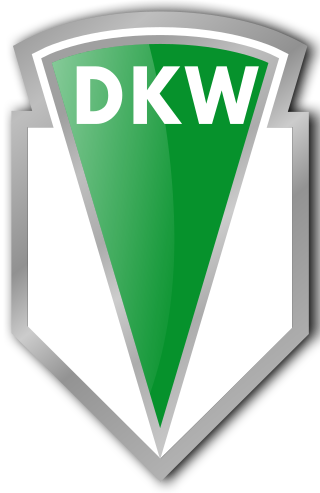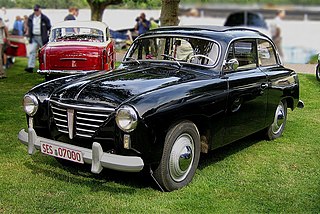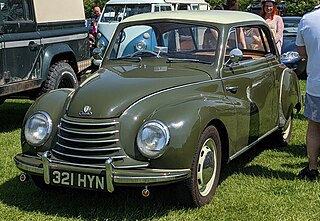
DKW was a German car- and motorcycle-marque. DKW was one of the four companies that formed Auto Union in 1932 and thus became an ancestor of the modern-day Audi company.

The Audi 80 is a compact executive car produced by the Audi subdivision of the Volkswagen Group across four generations from 1966 to 1996. It shared its platform with the Volkswagen Passat from 1973 to 1986 and was available as a saloon, and station wagon — the latter marketed by Audi as the Avant. The coupé and convertible models were not badged as members of the range, but used a derivative of the same platforms.

The Aero was a Czechoslovak automobile company that produced a variety of models between 1929 and 1947 by a well-known aircraft and car-body company owned by Dr. Kabes in Prague-Vysocany. Now Aero Vodochody produces aircraft only.

The Škoda Rapid is a fastback coupé designed and built by AZNP in Czechoslovakia between 1984 and 1990. Based on the rear-engined Škoda 105 120 and 130 saloon, it was a replacement for the Škoda Garde coupe built between 1981 and 1984 itself based upon the Škoda 105/120 sedan design, which was also called the Rapid in the UK market. Some Garde/Rapid cars were sent to Ludgate Design & Development in Kent, United Kingdom, by Škoda to be converted into convertibles.

Eucort was a Spanish automobile manufacturer based at Barcelona from 1945 till 1953.

The Borgward Hansa 1500 is a medium-sized automobile manufactured by the Bremen based auto-manufacturer Carl F. W. Borgward GmbH from 1949 until 1954. It was first presented at the Geneva Motor Show in March 1949 and production commenced on 13 October 1949. The similar Hansa 1800 was introduced in 1952. The Hansa was replaced by the Borgward Isabella in 1954.

The Goliath GP700 is a small automobile which was manufactured by the Bremen, Germany–based Borgward subsidiary Goliath-Werke Borgward & Co from 1950 to 1957. In 1955, the GP700 was joined by the larger-engined Goliath GP900 E. From 1951 to 1953, a coupé version, the Goliath GP700 Sport was offered. The Goliath was a revolutionary design, which in several important respects pointed the way for automobile development in the second half of the 20th century.

The DKW 3=6 is a compact front-wheel drive saloon manufactured by Auto Union GmbH. The car was launched at the Frankfurt Motor Show in March 1953 and sold until 1959. It carried the name Sonderklasse on the right hand fender of all steel bodied models – this being part of the model name for this range. The first model in the range was named by factory project number, DKW F91, which was replaced by the F93 and F94 models from the 1956 model year. The F93 and F94 models were referred to by Auto Union as the "Big DKW 3=6". From 1958, by which year the car's successor, the Auto Union 1000 Coupe de Luxe, was already being sold and the earlier version had therefore become, in essence, a ‘run-out’ model, it was known more simply as the DKW 900.

The DKW Meisterklasse, also known as the DKW F89, is a compact front-wheel drive saloon manufactured by Auto Union GmbH between 1950 and 1954. It was the first passenger car to be manufactured by the new Auto Union company in West Germany following the re-establishment of the business in the west in 1949.

The IFA F9, subsequently rebadged as the EMW 309, is a compact saloon manufactured under the auspices of the Russian and East German states between 1949 or 1950 and 1956. It was initially built at Zwickau at the plant previously owned by Auto Union. In 1953 production was transferred to the EMW, former BMW manufacturing plant at Eisenach under the name EMW 309 until 1956 where its underpinnings subsequently found their way into the Wartburg 311.

The DKW F8 is a compact front-wheel drive two-stroke engined saloon, introduced in 1939. The F8 was slightly shorter than its predecessor despite having a marginally increased wheelbase. The base model, known as the Reichsklasse, was manufactured only till 1940 but the Meisterklasse sedan continued in production until 1942. In addition to the saloons, cabriolet versions were offered.

The DKW F7 is a front-wheel-drive, two-stroke, subcompact family car produced by Auto Union’s DKW division from 1937 to 1938, succeeding their DKW F5 range. In the F7 update, the slightly smaller entry-level 'Reichsklasse' body was dropped – instead all F7s, including the base trim, now got the slightly longer body previously reserved for the 'Meisterklasse' model.

The DKW Junior is a small front wheel drive saloon manufactured by Auto Union AG. The car received a positive reaction when first exhibited, initially badged as the DKW 600, at the Frankfurt Motor Show in March 1957. The ‘Junior’ name was given to the DKW 750 in 1959 when the car went into volume production, but failed to survive an upgrade in January 1963, after which the car was known as the DKW F12. In addition to the saloon, a pretty ‘F12 Roadster’ was produced in limited numbers.

Initially presented early in 1933, the Audi Front UW 220 was Europe’s first car to combine front-wheel drive with a six-cylinder engine. It remained in production for slightly under two years before being replaced by the Audi Front UW 225 featuring a larger 2.25-litre engine. The larger-engined car introduced in 1935 was built till April 1938 and continued to be listed into 1939. Between 1933 and 1938, the Front was the only Audi in volume production.

The DKW F2, firstly marketed as "DKW Meisterklasse", is a front wheel drive economy car produced by Auto Union's DKW division from 1932 to 1935 at the company’s Zwickau plant. It was launched at the Berlin Motor Show in April 1932. It shared its 584cc engine and drivetrain with its DKW F1 predecessor, but offered a longer wheelbase and a larger body.

The DKW F4 Meisterklasse is a small car produced at the company’s Zwickau plant by DKW between 1934 and 1935. It shared its 692cc engine and front wheel drive configuration with its immediate predecessor, the DKW F2 Meisterklasse, along with its 2,610 mm (103 in) wheelbase, but the body had been restyled again, and was now more stylish, the perpendicular rear end of the F2 now replaced with a sloping rear on the mainstream body types

The DKW Typ 4=8 is a small rear-wheel drive two-stroke V4 engined car produced at the company's Spandau plant by DKW. It was launched at the Berlin Motor-show in 1929 as a successor to the DKW Typ P built at the same factory, although the DKW Typ P 4=8 was significantly larger than the Typ P: in terms of market positioning a more direct successor to the DKW Type P was probably the DKW F1 produced in Zwickau from 1931.

The Adler Primus is a small family car introduced by the Frankfurt based auto-maker, Adler in March 1932. In a move reminiscent of British Leyland in the 1970s, Adler launched two similarly sized cars in the same year, one of which followed the then new trend set by DKW for front-wheel drive, and one respecting the conventional rear-wheel drive configuration still used by the market leader, Opel.

The Adler Trumpf is a small family car introduced by the Frankfurt based auto-maker, Adler in March 1932, with Trumpf production fully starting in the late summer that year. In a move reminiscent of British Leyland in the 1970s, Adler launched two similarly sized cars in the same year, one of which followed the 1931 DKW F1's then innovative front-wheel drive layout, and the other model using the conventional rear-wheel drive configuration still used by then market leader, Opel's 1.2 litre 'model 6'.

The Adler Trumpf Junior is a small family car introduced by the Frankfurt based auto-maker Adler, early in 1934. Trumpf Junior was conceived as a similar but smaller version of the Adler Trumpf, which had already been available for two years. It intended to broaden the range and claim a share of a growing market which DKW were creating with their F1 model, and its successors, for small inexpensive front wheel drive cars.





















